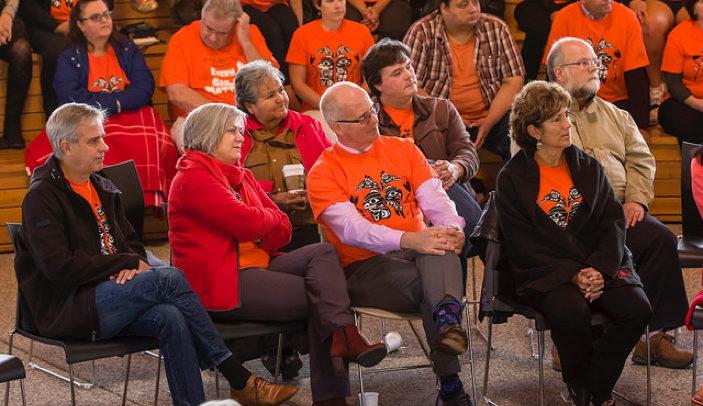7 Isick (Paddle)
Now that your Indigenization journey has launched, this is the time to consider how to synchronize the paddle strokes. Often a journey involves getting to know one another in the canoe, by telling stories and recognizing what needs to be done to reach the destination.
Nella Nelson shared the following:
I’m really blessed because my mom is a real social butterfly and did lots of visiting, and we didn’t have television. What I didn’t realize then was that I was incorporating the stories I heard. Now I find that every time I’m going to do a presentation I’m always thinking about a story or an experience that I can share, because it’s the stories that will bridge the hearts, not the facts. What you’re doing is going to that heart place, and people will then take that experience on for themselves. They can see themselves in your story. So stories are really critical in how we broach and work through things, and like I said, I have been really blessed to be a witness to a lot of stories.

Orange Shirt Day, Camosun College, 2016.
Angus Graeme described how Selkirk College fundraised and built a Gathering Place at the Castlegar campus. The 2012 opening of the Gathering Place was a watershed moment, after which the college began offering more comprehensive student supports, ceremony, celebrations of traditions, and learning experiences for students and the community. Angus said:
We have held three multi-day youth conferences celebrating Indigenous youth, culture, and learning. We started an Elders-in-residence program in 2015. We have brought a number of important guest speakers to the college (including Wab Kinew and Justice Murray Sinclair). We have regular cultural activities in the Gathering Place and at our other sites (drumming, smudges, Elders, cultural evenings). Staff in our Aboriginal Services department are currently renewing and expanding our Indigenization Plan for the college…. We are currently undertaking SSHRC-funded research with our nation partners on reconciliation through college education.
Ceremony and coming together in community to share stories are among the most effective ways to isick. It creates the bonds and connections that facilitate paddling together.
Camosun College has embraced storytelling as an effective way of bringing to life college values around Indigenization. In February each year, the entire college community gathers for Conversations Day. An invited speaker, such as Richard Wagamese and Chief Robert Joseph, shares their story. The listeners – 700 people representing every part of the college – then take time to connect in small groups and talk on more personal level. The day also features speakers from the college who address the audience with their own personal story. The stories and the opportunity to listen, laugh, and cry together cement the bonds of relationship across the college.
In the process of preparing to isick you begin to build an understanding of who Indigenous Peoples are and the need to Indigenize your institution. Understanding the why of Indigenization provides the time and space to develop a genuine acknowledgement of Indigenous Peoples. Protocols such as acknowledging territory in an institutional ceremony like graduation come more naturally. It is important to know and understand who the Indigenous Peoples of the territory you work, live, and play on are. Territorial acknowledgements vary, so take time to learn what is most appropriate or acceptable on your territory, and learn to adjust when you visit other institutions.
Attributions
Fig 2.2: Orange Shirt Day Sept 30 2016-047 by Camosun College AV Services is used under a CC BY-NC 2.0 Generic Licence.

